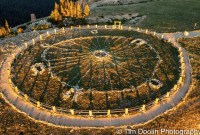Are All Native American Medicine Wheels the Same?
Native American medicine wheels are ancient stone structures that are found across the United States and Canada. They have been used for thousands of years by various tribes, and they are still used today by some communities for ceremonies and other purposes. While the basic design of a medicine wheel is generally the same, the specific meanings and uses of the structures vary greatly depending on the tribe that created them.
What is a Medicine Wheel?
A medicine wheel is a circular arrangement of stones that typically includes a central cairn or hub, spokes that radiate outwards from the center, and an outer rim. The size and complexity of medicine wheels vary widely, from simple structures with a few stones to elaborate constructions with numerous spokes and features.
The basic design of a medicine wheel represents the interconnectedness of all things. The circle symbolizes the cyclical nature of life, death, and rebirth. The center represents the self or the Great Spirit. The spokes represent the various aspects of life, such as the four directions, the four seasons, or the four stages of life. The outer rim represents the boundaries of the world.
Origins and History
The exact origins of medicine wheels are unknown, but the earliest known examples date back thousands of years. The oldest and largest medicine wheel is the Bighorn Medicine Wheel in Wyoming, which is estimated to be around 7,000 years old. Other well-known medicine wheels include the Moose Mountain Medicine Wheel in Saskatchewan, Canada, and the Majorville Cairn and Medicine Wheel in Alberta, Canada.
The construction of medicine wheels was a significant undertaking, requiring the careful selection and placement of stones. The construction process itself was often a sacred act, and the builders would have had a deep understanding of the spiritual and cosmological significance of the structure.
Diversity of Meanings and Uses
While the basic design of a medicine wheel is consistent, the specific meanings and uses of the structures vary greatly depending on the tribe that created them. Each tribe had its own unique beliefs and traditions, and these were reflected in the way they built and used their medicine wheels.
For some tribes, medicine wheels were used for astronomical observations. The spokes of the wheel could be aligned with the solstices, equinoxes, and other celestial events. This allowed the tribes to track the seasons and plan their activities accordingly.
For other tribes, medicine wheels were used for healing and spiritual ceremonies. The center of the wheel was often considered a sacred space, and it was used for prayers, meditations, and other rituals. The spokes of the wheel could be used to represent the different aspects of the human experience, such as the physical, emotional, mental, and spiritual realms.
Medicine wheels were also used for teaching and learning. They could be used to teach children about the interconnectedness of all things, the importance of balance and harmony, and the values of their culture.
Some tribes used medicine wheels as burial grounds. The central cairn or hub could be used to house the remains of important individuals, and the spokes of the wheel could be used to mark the locations of other burials.
Differences Between Medicine Wheels
One of the main differences between medicine wheels is the size and complexity of the structure. Some medicine wheels are small and simple, while others are large and complex.
Another difference is the materials used to construct the wheel. Some medicine wheels are made of stone, while others are made of earth or wood.
The number of spokes in a medicine wheel can also vary. Some medicine wheels have four spokes, while others have eight, twelve, or even more.
The orientation of the medicine wheel can also vary. Some medicine wheels are aligned with the cardinal directions, while others are aligned with the solstices or other celestial events.
The specific meanings and uses of the medicine wheel also vary depending on the tribe that created it. Some tribes used the medicine wheel for astronomical observations, while others used it for healing and spiritual ceremonies.
Respecting Native American Traditions
It is important to respect Native American traditions and cultures when visiting or learning about medicine wheels. Medicine wheels are sacred sites, and they should be treated with respect and reverence.
If you are visiting a medicine wheel, it is important to follow the guidelines set by the local tribe. This may include staying on designated paths, refraining from touching the stones, and not taking any artifacts from the site.
It is also important to learn about the history and culture of the tribe that created the medicine wheel. This will help you to understand the significance of the structure and to appreciate its beauty and complexity.
Conclusion
Native American medicine wheels are fascinating and complex structures. While the basic design of a medicine wheel is generally the same, the specific meanings and uses of the structures vary greatly depending on the tribe that created them. It is important to respect Native American traditions and cultures when learning about medicine wheels. By understanding the history, beliefs, and traditions of the tribes that created these structures, we can gain a deeper appreciation for their significance and beauty.



